Movie Review – Toy Story
The most original, classic animated film of all time – the one which kicked off an entire industry of related films – Toy Story.
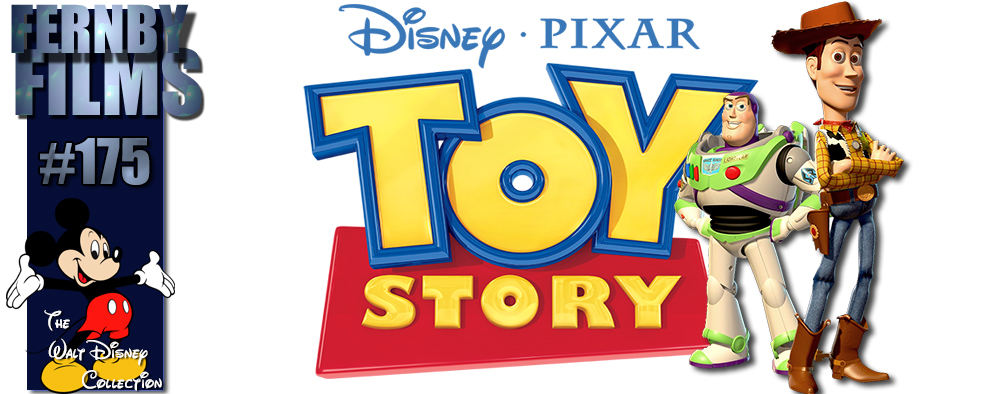
– Summary –
Director : John Lasseter
Cast : Voices of: Tom Hanks, Tim Allen, Joan Cusack, Don Rickles, Jim Varney, Wallace Shawn, John Ratzenberger, Estelle Harris, Laurie Metcalf, Annie Potts, John Morris, Erik von Detten, R Lee Ermey.
Year of Release : 1995
Length : 81 Minutes
Synopsis: A young boy’s toys come to life when humans are not around. A toy cowboy named Woody becomes jealous of the newer, space-aged Buzz Lightyear toy when his owner is given one for a birthday present.
Review : Animated, cinematic brilliance. Impossible to criticize, Toy Story stands the test of time as a classic piece of entertainment.
*********************
In the age of modern cinema, there’s very few people alive today who would not be aware of the seemingly miraculous rise, and rise, of super-studio Pixar, the guys behind the enormously successful Toy Story, Monsters Inc., The Incredibles, and more recently WALL-E, and Ratatouille. Pixar, now owned by Disney, has had a tumultuous history in it’s relatively short life. It began life as a division of Lucasfilm, known as Graphics Group, before being taken over by Apple co-founder Steve Jobs, and then, in the late 80’s began to experiment with the art of computerized animation. In the 90’s, Pixar struck a deal with Disney to produce three full length animated films, with Toy Story being the first off the line. The rest, as they say, is history.
When Toy Story was unleashed upon the cinema-going public in 1995, after many years of work had been put into it, there were fears it wouldn’t succeed. It was a relatively new technology, which up until then had predominantly been used in smaller, less expensive projects like short films, and TV commercials. There was a lot riding on the new film, and with plenty of money to be made if it succeeded, there were a lot of nervous people around both companies’ offices.
Neither should have worried. Toy Story quickly became one of the highest grossing films of 1995, and went on to become one of the highest grossing animated films in history. It’s success spawned a sequel (which, in turn, has spawned a second sequel) and catapulted Pixar to the top of the studio heap for animation. Toy Story single-handedly revolutionized the animation industry, setting benchmark after benchmark for everything from storytelling, to animation, to characterization techniques, that have ensured the studio has remained the Top Dog of animation ever since. Since Pixar’s success, both 20th Century Fox and Dreamworks set up their own animation studios (Fox funded Blue Sky Studios to produce Ice Age and Robots, while Dreamworks pictures developed Shrek, Madagascar and the like) while Pixar has moved from strength to strength, producing films of increasing quality in the years since.
So what is it about Toy Story that polarized audiences across the planet, the fact that it’s the worlds first CGI animated film notwithstanding?
We begin with a young boy, Andy, playing with his toys, while waiting for his friends to arrive for his birthday party. When Andy leaves the room, the toys are still, silent. The camera moves closer, closer to one, a wooden cowboy doll, whom we overhear Andy calling Woody. There room is still, and then, suddenly, Woody’s eyes move, and he sits bolt upright, proclaiming “Alright everyone, he’s gone”. With that, the room bursts to life with the sounds and movement of dozens of tiny toys, of various sizes and shapes. Toys of all manner of brand and shape emerge from the various boxes, shelves and hidden places of Andy’s bedroom. Woody, a veritable Mr Organization, gets the toys gathered around him to begin their plan to spy on Andy and his friends, to see what new toys are about to come into their lives. You see, with Andy unwrapping his birthday presents, there’s every chance a new, unliked toy might become part of their “family”, and the toys all want to hear what it might be. The anticipatory level within the bedroom is immense. The sarcastic, cynical Mr Potato Head badly wants to get his hands on a Mrs Potato Head, although it hasn’t happened yet. Hamm, a pig shaped money boy seems intent on being the local wiseguy, his quips and put-downs razor sharp and always hitting home. Woody’s lady “friend”, Bo Peep, is not one of the toys you’d think you might find in a boys bedroom, but since Andy has a baby sister, it’s not unlikely.
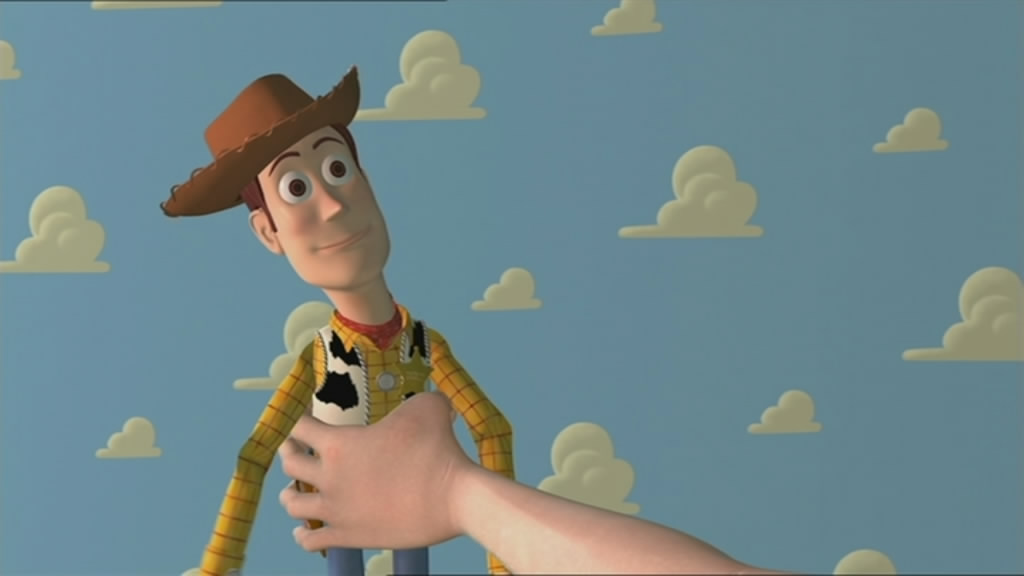
Using the toy soldiers in a giant bucket to spy on Andy and the party downstairs, they check off the various presents with increasing joy that among them is not some violent, degenerate toy who will threaten their way of life. Until, in a frenzy of action, Andy unwraps his last, and largest, toy. Blindsided by the rest of the children in the room, the solder captain cannot relay the message to Woody via the walkie-talkie, and the present, whatever it is, is quickly absconded with back to Andy’s room, where the toys must now hurry to return to their original positions. The kids all run in, whooping and hollering, chattering about how cool the new present is, just out of the eyeline of Woody himself.
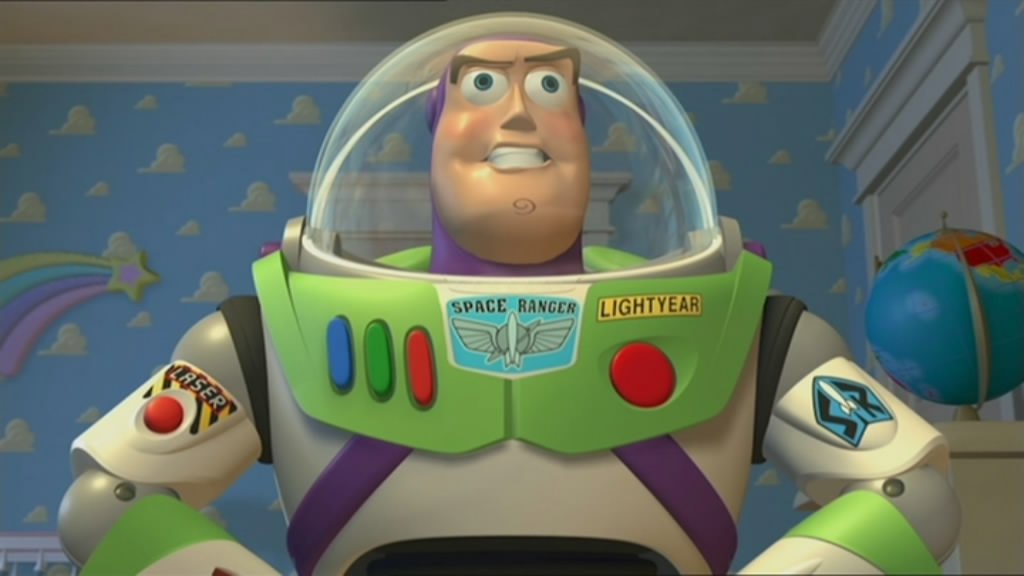
Then, the children are called for food, and the new present is plonked firmly on top of Andy’s bed, a position we find out is normally reserved for Woody. Woody, brushed aside in the fervor, clambers back onto the bed, and looks up, at the new toy which has usurped his position in Andy’s favor. It is Buzz Lightyear. A space toy, a light-flashing, helmet wearing, “flying” toy who has no idea he’s actually a toy. Buzz, viewing the rooms occupants with the disdain and arrogance of a spaceman landing on a planet unfamiliar, manages to insult Woody quite quickly, and begins regaling the rest of the toys (who, by the way, are in awe of the new addition to Andy’s collection) with his exploits.
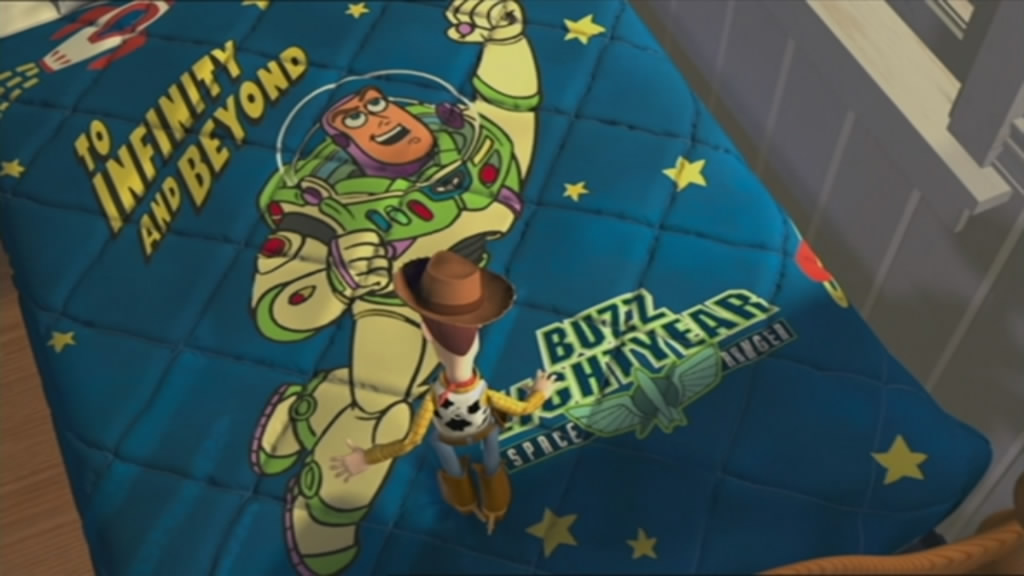
So begins Toy Story. The film uses themes of acceptance, jealousy, the sense of loss of place and a desire to be loved, to the most accessible, and unpretentious, manner possible in a film. Disney’s ethical stance on family, friendship and love are all in place, and Pixar’s storytellers have crafted a beautiful, wondrous story of two kindred spirits who don’t quite know it yet. Woody, voiced by Tom Hanks, is the jealous one, his position as Head Toy gradually being usurped by Buzz. It annoys him, so, of course, he set’s about trying to get rid of the newcomer, who he perceives as a threat. Of course, this is indicative of what we humans do when we come across something that threatens us: we try and get rid of it. Buzz is arrogant, self-assured and, unlike Woody, confident. Woody’s inability to see himself as a man of action is offset by his actions throughout the film, a quite contradictory manner he portrays as he comes up with a diabolical plan to rid his life of Buzz. Originally, director John Lasseter and the team at Pixar had Woody as a bit of a jerk, his action more overt in getting rid of Buzz, rather than the more understandable jealousy with which they imbued him. Woody is a sympathetic character here, since we can all recognize within him the sense of loss at his life being turned upside down. Buzz, in a great performance by Tim Allen, begins to come to terms with the fact that he is, in fact, a toy, and not a space-faring adventurer with lasers on his arms and mechanical wings on his back.
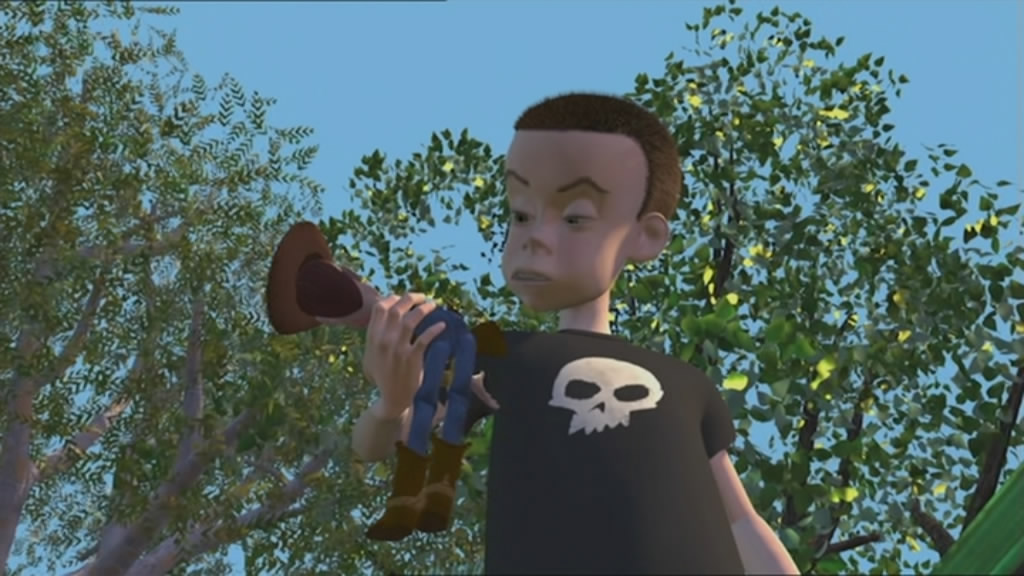
It’s this story point that I think Pixar excels at: showing us just how amazing they can be when allowing a character to follow his own path. Buzz doesn’t simply get told that he’s a toy and falls to the floor in a weeping mess, no, he is utterly convinced that he is what his packaging tells kids. Flying in the face of reason, Buzz embarks on a “mission” to repair his damaged craft (the box he arrived in, which is shaped like a plane) and sets in motion a series of adventures that take the toys away from the house and into the world. Danger lurks around every corner. The boy next door, a vicious thug named Sid, who enjoys destroying any toy he can find with the most abhorrent methods possible, is a constant threat. There’s the very real possibility that the toys will be discovered to be “alive” and made a spectacle of.
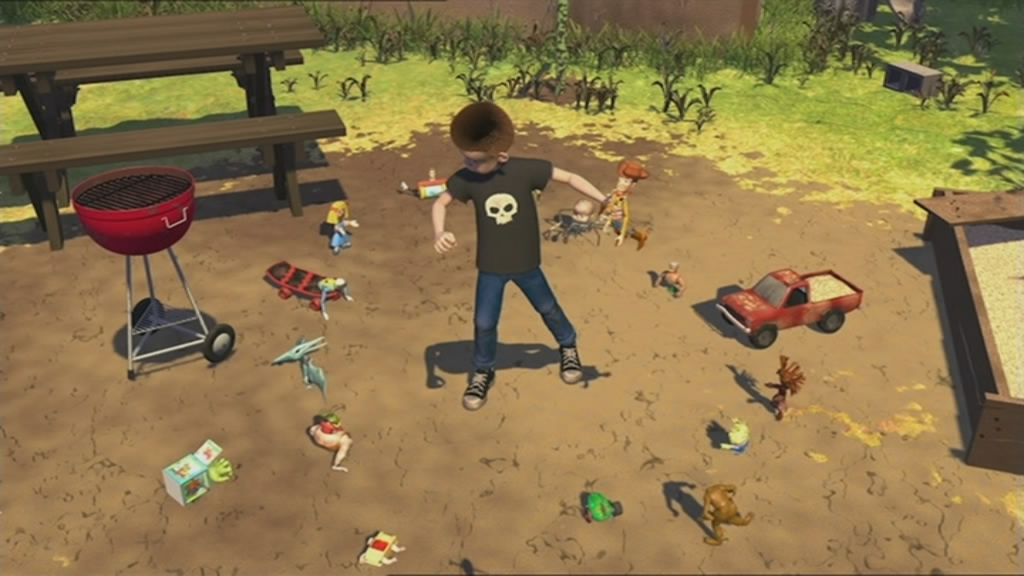
As Woody begins to appreciate Buzz’s friendship, and Buzz learns quite harshly that he is, in fact, a toy, the two come to an understanding of one another, and their own positions in the world. Woody learns that he doesn’t have to be the leader of the group, and that the toys are perfectly capable of looking after themselves. His position with Andy as his favorite toy is transitory anyway, which is a lesson he learns harshly, yet seems to accept quite readily by the end of the film. Buzz, his attitude towards Woody at first belligerent, and then more mellow, learns that he is one of millions of mass produced versions of the same toy, and while initially flipping out, and drinking tea with Mrs Nesbitt at Andy’s sister’s dolls tea party, he comes round.
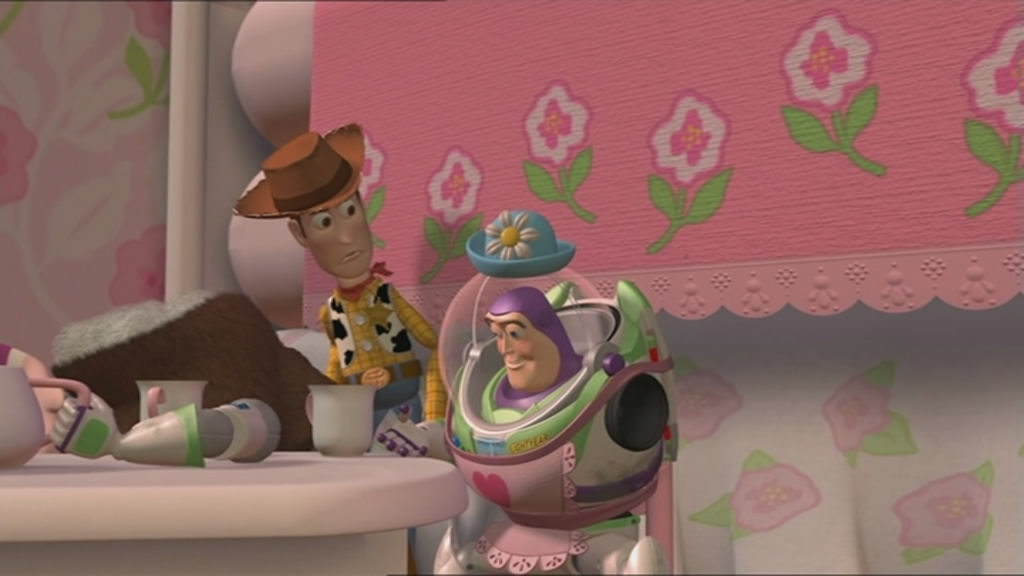
So where does Toy Story gain it’s appeal? Is it the animation? The storytelling? The characters? Honestly, I believe the film uses all it’s various facets to create a magnificent whole: all aspects of the film combine in a perfect symmetry of story that would, if you removed but a single part, collapse into mediocrity. Pixar’s attention to their characters is legendary. After all, if you don’t have good, solid characters, your film will simply fail. People need characters they can empathize with, identify with, to enjoy a film with. There’s no point in having characters who behave out-of-character for the sake of a story direction. Woody, Buzz, Hamm, Potato Head, even Sid, all behave in such a believable way, and true to their motivating characterizations, that they seem all the more real than had they been merely clichéd, generic versions. They are given personality by the animators, but also by the actors providing the voices. Hanks and Allen are superb in their roles as Woody and Buzz respectively. John Ratzenberger, perhaps best known as Cliff from the television series Cheers, is a scream as Hamm, and Wallace Shawn (whose distinctive voice landed him various stage and screen parts over the years) is wonderful as the timid toy tyrannosaurus Rex.
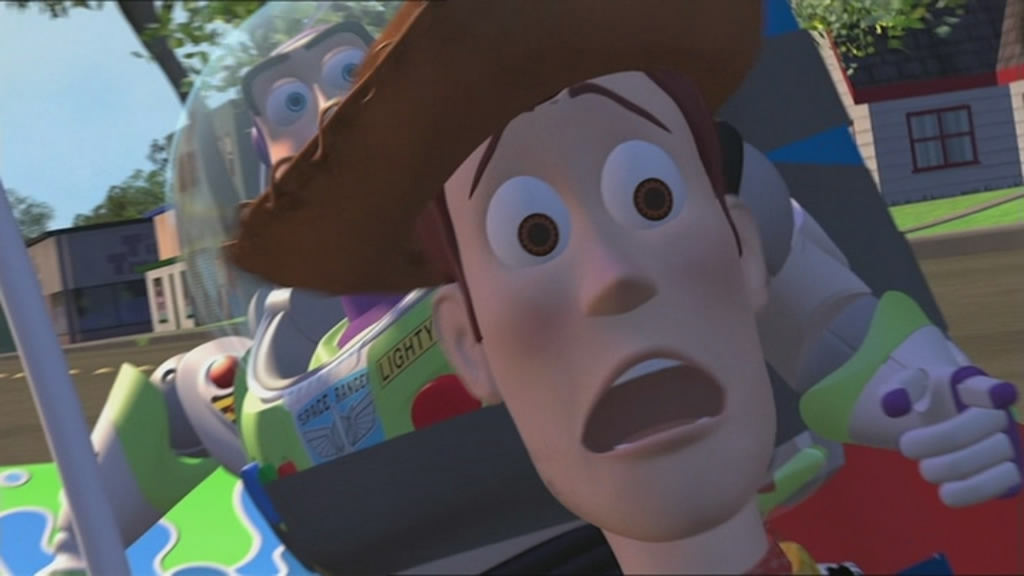
But it is not just the voices that drive the characters, although it is a fair portion. The animation on Toy Story still stands up to modern scrutiny, more than a decade on from it’s original release. With an eye-pleasing color palette and some amazing, advanced, special effects and animation, the world of the toys is perfectly realized by (and perfects suited to) the animated style from Pixar. Buzz, his helmet transparent and wing-tips lit up with light, is a perfect symbol of the dazzling potential of computer animation. He’s a real toy, on screen at least, and looks so amazingly detailed it’s breathtaking. Woody’s clothing seems so real, you almost feel you could reach out and touch it. Advances in technology since the 90’s, when Toy Story was released, mean that today, the original film feels a little anemic by comparison, but at the time, was revolutionary for it’s mastery of realism.
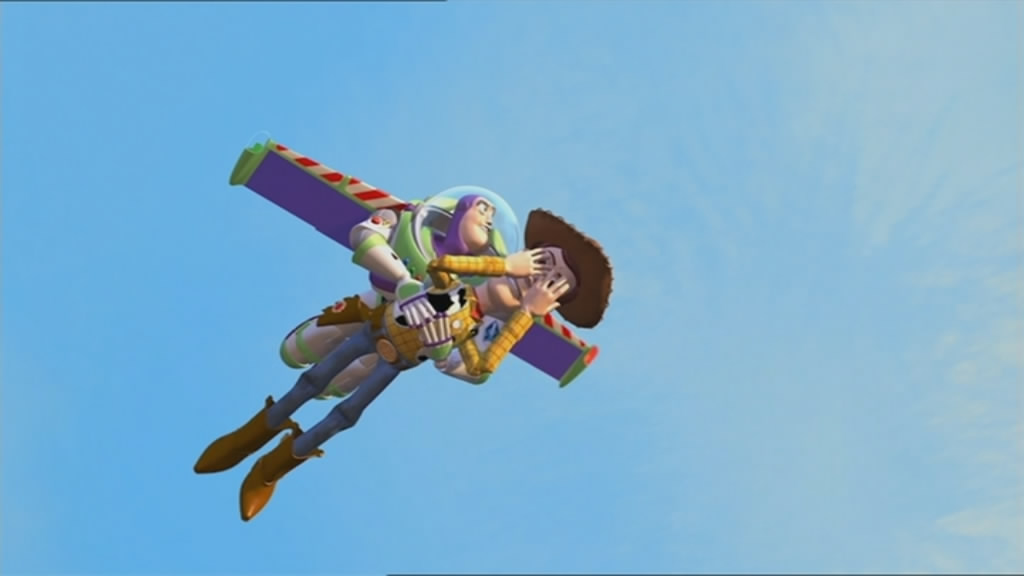
Yet, it’s not even this realism and superior technological skill that make Toy Story a true classic of modern film. What I think does it is the simple fact that the combination of great writing, some well rounded and developed characters, as well as the cinematic skill involved in bringing such a world to life, remains some way behind the fact that it’s the very essence of the story that makes this so accessible. Themes are overarching in their simplicity, they touch a part of each and every one of us, and that, in a way, brings us much closer to the story than you first think. Plus, it’s utterly entertaining, which merely serves to broaden it’s appeal as a film.







